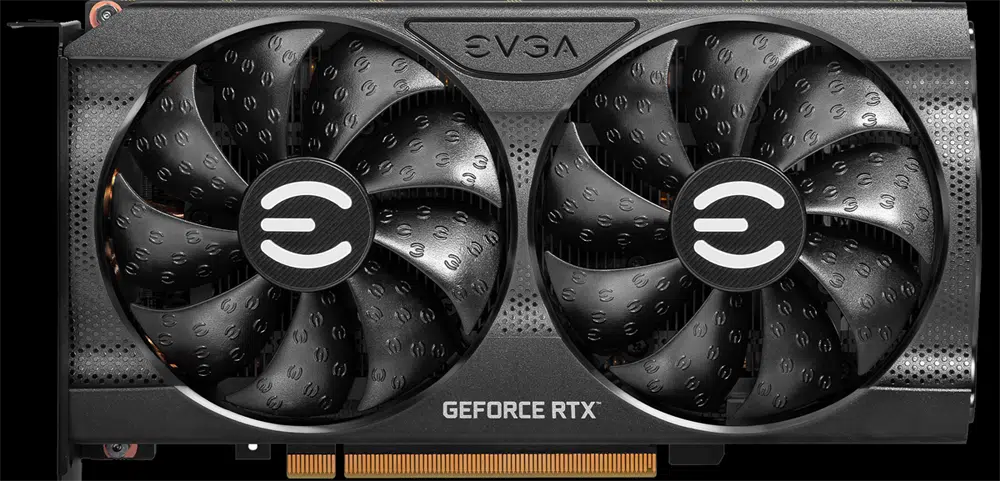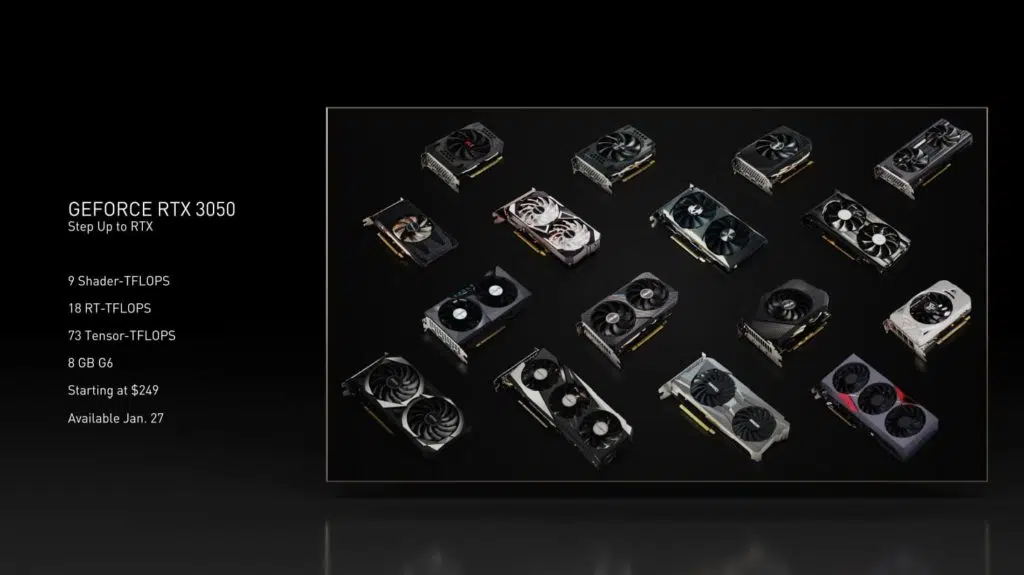
Introduction
NVIDIA’s answer to the entry-level to mainstream desktop PC gaming market at 1080p is here, today NVIDIA is launching the GeForce RTX 3050 GPU. We have a full retail boxed version of the EVGA GeForce RTX 3050 XC BLACK GAMING video card (with a factory overclock) for review today. We’ll dive into the new GPU, go over its specifications, talk about how it compares to the Radeon RX 6500 XT, and dive into performance. Oh yes, we will overclock it as high as we can as well.
This review will show what level of gameplay settings the GeForce RTX 3050 is playable at in games and what kind of gameplay experience it delivers. We will utilize various game quality settings at 1080p plus DLSS, FSR, and Ray Tracing. We will compare performance against the new Radeon RX 6500 XT, as well as an upgrade from the GeForce GTX 1650.
NVIDIA GeForce RTX 3050

NVIDIA is launching the GeForce RTX 3050 today, with an MSRP of $249. Availability will take place on January 27th, and as is standard for today’s market actual availability and street pricing will vary. We hope it is more available than previous GPUs have been. If the mining claims are true, it may not suit miners well, and thus could lead to wider availability for gamers, we will see.
The GeForce RTX 3050 is poised to take on the high-end of the 1080p gaming experience. It can be seen as an upgrade from the GeForce GTX 1650 which was released in 2019. An important note, the GeForce RTX 3050 has the full 7th Generation NVIDIA Encoder (NVENC) media engine on board. This means it is capable of encoding H.264 and H.265 as well as decoding AV1. This is an important feature that the Radeon RX 6500 XT does not have.
Specifications
The GeForce RTX 3050 (GA106) is based on NVIDIA’s latest Ampere architecture found in the GeForce RTX 30 series of GPUs. It is manufactured on Samsung’s 8nm FFN process technology with a 12 billion transistor count. For comparison, the GeForce GTX 1650 had 4.7 billion transistors on 12nm FFN.
| Specification | GeForce RTX 3050 | GeForce GTX 1650 |
|---|---|---|
| Fabrication Process | SAMSUNG 8nm FFN | TSMC 12nm FFN |
| Architecture | Ampere | Turing |
| CUDA Cores | 2560 | 896 |
| ROPs | 48 | 32 |
| Texture Units | 80 | 56 |
| RT Cores | 20 (2nd Gen) | N/A |
| Tensor Cores | 80 (3rd Gen) | N/A |
| Boost Clock | 1777MHz | 1665MHz |
| Memory | 8GB GDDR6 | 4GB GDDR5 |
| Memory Frequency | 14GHz | 8GHz |
| Memory Bus Width/Bandwidth | 128-bit / 224GB/s | 128-bit / 128GB/s |
| Media Encoder | Yes (7th Generation) | Yes (5th Generation) |
| TGP | 130W | 75W |
| MSRP | $249 | $149 |
The GeForce RTX 3050 consists of 2 Graphics Processing Clusters, 10 Texture Processing Clusters, and 30 Streaming Multiprocessors. It has 2560 CUDA Cores, 48 ROPs, and 80 Texture Units. As it is an RTX GPU it also has 80 3rd Generation Tensor Cores and 20 2nd Generation RT Cores. It fully supports Ray Tracing and NVIDIA DLSS, something the GeForce GTX 1650 did not have either of. The GeForce RTX 3050 will have a Boost Clock of 1777MHz. Since it also supports NVIDIA GPU Boost the actual in-game frequency while gaming will be much higher as allowed.
On the memory side of things, the GeForce RTX 3050 is equipped with 8GB of GDDR6 memory, so even at 1080p, it will have plenty for today’s and future games. This means it is potentially capable of High to Ultra settings at 1080p without thrashing out of the framebuffer. The memory runs at 14GHz and with a 128-bit memory interface, this gives it 224GB/s of memory bandwidth. This is 75% more than the GTX 1650.
This is all packaged up into a Total Graphics Power (TGP) of 130W. Video cards will be in a dual-slot configuration and recommended PSU is 550W. Add-in-Board partner video cards will utilize a standard 8-pin PCIe power connector. The GeForce RTX 3050 also has a full array of display connectors with 3x DisplayPort and 1x HDMI, for a total of 4 display outs.
| Specification | GeForce RTX 3050 | Radeon RX 6500 XT |
|---|---|---|
| Fabrication Process | SAMSUNG 8nm FFN | TSMC N6 |
| Boost Clock | 1777MHz | 2610MHz/2815MHz |
| Memory | 8GB GDDR6 | 4GB GDDR6 |
| Memory Frequency | 14GHz | 18GHz |
| Memory Bus Width | 128-bit | 64-bit |
| Memory Bandwidth | 224GB/s | 144GB/s |
| PCI-Express Interface | PCIe 4.0 x8 | PCIe 4.0 x4 |
| TGP/TDP | 130W | 107W-120W |
| Media Encoder | Yes (NVIDIA Encoder) | No |
| MSRP | $249 | $199 |
Features
We also cannot forget the other features NVIDIA provides with GeForce RTX GPUs, which the GeForce RTX 3050 fully supports. You get NVIDIA Broadcast: AI-Powered Video and Voice support, and with the NVENC media engine you can stream with hardware encoding. There is also support for NVIDIA Reflex: Low Latency Technology, an important feature for 1080p fast-twitch, e-Sports type gaming that this video card is aimed at to help improve latency.
You also get full DLSS support in games that utilize DLSS to speed up performance and make game settings playable that wouldn’t be before. You also get Ray Tracing support now in a cheaper-priced video card. There are now over 200 RTX capable games, and over 145 games with DLSS. The RTX 3050 also supports NVIDIA’s Image Scaling driver-based spatial upscaler technology as well.
